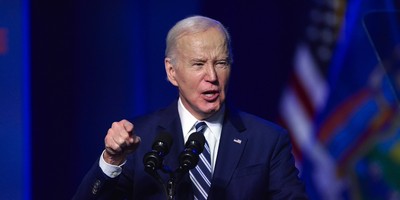Russia's "Crimean Precedent" -- the brazen military invasion and imperial political annexation of sovereign territory -- has shredded several key post-Cold War diplomatic agreements and treaties.
To the chagrin of China, this 21st-century object lesson in authoritarian depredation and brute military force now provides Japanese Prime Minister Shinzo Abe with the decisive political opportunity to rip a vexing clause or two from Japan's post-World War II "peace" constitution.
With the rape and devastation of Asia by Imperial Japanese military forces a raw memory, that liberal democratic constitution, drafted by the U.S. and allied victors and imposed in 1947, placed severe constraints on the size, structure and operational sphere of Japanese military forces. Postwar Japan, a nation reborn, could not field an army and navy, only the Japanese Self-Defense Force. The JSDF's sea, air and land components were built and deployed for the local defense of Japan's home islands. The law forbade the offensive use of JSDF forces and restricted deployments beyond Japanese territory. The Imperial Japanese Navy, 1942's scourge of the Pacific and Indian Oceans, was reduced to a coast guard, the Japanese Maritime Self-Defense Force.
For some three decades, Japan, distrusted and disliked (if not despised) throughout Asia, abided by the constitutional restrictions. Air and sea rescue missions, and training exercises with the U.S. and other allies stretched the practical definition of local, but with good reason. Japanese policymakers discovered that American military domination and their country's military limitations had economic and diplomatic benefits. With the U.S. shouldering the security burden and paying for it, Japanese Cold War-era diplomats emphasized Japan's economic dynamism.
Recommended
But as time passes, threats and technology change. In the late 1970s and early 1980s, Japan confronted Russia's East Asian military build-up. As China's economic and military modernization programs gained momentum, Japan reflected on China's 1974 seizure of Vietnam's Paracel Islands. Japan modernized its air defense force, acquiring long-range interceptors. With U.S. support, Japan's patrol aircraft expanded their patrol area up to 1,000 kilometers from the islands or more if required.
As it built ballistic missiles and sought nuclear arms, North Korea emerged as a regional threat. A North Korean nuke could incinerate Tokyo as well as Seoul. Air and sea forces needed longer-range anti-ship missiles and anti-submarine weapons. Are anti-ship missiles offensive weapons? Well, cruise missiles can strike land targets. Does this violate the constitution?
Japanese security officials became convinced theater missile defense was a necessity. In 1988, the government ordered the JMSDF (navy) to build Kongo-class destroyers. These ships would have the U.S. Navy's Aegis air defense system and could eventually serve as anti-ballistic missile platforms. Though, at the time, rank speculators in the U.S. media proposed a U.S.-Japan alliance breakup was imminent (a few speculated on a U.S.-Japan war), Chinese military analysts argued the expensive Kongo destroyer program confirmed Japan's commitment to its American ally. ABM's are defensive systems. However, by sharing advanced communications and sensor systems, the U.S. Navy and the JMSDF could fight as one fleet. If the U.S. were conducting offensive operations, would the JMSDF violate the constitution if it provided the USN with targeting intelligence? Technology blurs distinctions.
So does diplomatic pressure. After divisive debate, Japan's parliament ultimately decided that Japanese soldiers could participate in international peacekeeping operations. Allies demanded that wealthy Japan "do its share." Now Japanese units deploy world wide. Japanese units went to Iraq on a nation-building mission.
Japanese doves claimed the government routinely circumvented constitutional limitations. However, the presence of increasingly lethal and long-range weapons in East Asia meant legitimate self-defense might begin at North Korean ICBM launch pad.
Prime Minister Abe argues that technology and current political threats, such as China's threats to seize the disputed Senkaku/Diaoyu islets, make the constitutional restrictions suicidal. Abe believes developing offensive capabilities will have a deterrent effect. He wants to amend the constitution, and he has full U.S. support. Abe says the time to do it is now, before China "pulls a Crimea" in the East China Sea.
























Join the conversation as a VIP Member